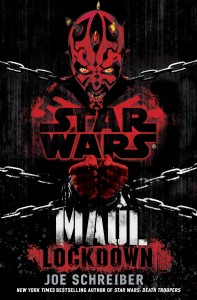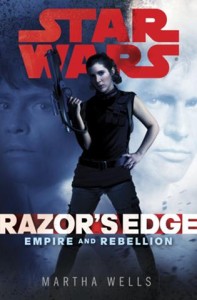—–WARNING, MILD SPOILERS AHEAD—–

“Well, if there’s a bright center to the universe, you’re on the planet that it’s farthest from.” – Luke Skywalker
Kenobi opens onto a galaxy that has been ravaged by three years of open civil war. Countless planets lie in ruin, and countless rim populations are warily, often forcefully, being brought back under the “protection” of the Old Republic, which is suddenly calling itself an Empire.
But as it happens, Kenobi opens on Tatooine. And Tatooine doesn’t give a shit.
Tatooine’s human population, the book is careful to point out, are settlers, nothing more—even those who’ve been there for generations. Kenobi‘s main human characters are Orrin Gault and Annileen Calwell (whose nickname, brilliantly, is “Annie”), two people who, while they’ve done pretty well considering the circumstances, would describe themselves as barely keeping their heads above water…so to speak. Life on Tatooine is a constant battle—against the elements, against destitution, and against the natives.
Which brings me to the third main character—the Tusken clan leader A’Yark. While Orrin and Annileen practically leap off the page from the get-go and easily overcome my reflexive aversion to excessive human characters, A’Yark is hands-down the most interesting thing about this novel, and every moment in the character’s head is a window to a new world. John Jackson Miller does a great job of incorporating all the existing bits of Tusken lore while creating a unique clan that’s not quite like any we’ve seen before—and in particular, one that’s unique to this point in time. Anakin’s slaughter of the Tusken camp in Attack of the Clones still weighs heavily on the Tuskens’ consciousness, but isn’t dwelled on excessively, or made into a giant plot point (nor, incidentally, are the Larses), because while A’Yark’s clan is shaped in a huge way by that event, this story isn’t about that.

This story also, by the way, isn’t about Obi-Wan. Obi-Wan is a giant stone thrown into the shallow pond that is the Pika Oasis, the community around which the book takes place, but Kenobi is very much the pond’s story. A rippling pond is still just a pond, however, and that brings me to the most important thing I have to say about Kenobi—this may be the smallest-scale Star Wars novel ever.
I knew right away that that would be the main point of this review, but in the month or so since I finished the book, what’s struck me is that it’s more true the more I think about it. There is no bad guy in Kenobi, no evil plot to foil. A’Yark is the most antagonistic, Annileen is the most sympathetic, and Orrin is, well, Orrin—but the story of Kenobi is the story of three people in a mess, and the stakes here are nonexistent beyond the lives of these three people and those they love.
What makes it work, simply, is that Miller creates excellent characters that you can identify with, and whose fates come to matter to you, despite the fact that a Star Destroyer could crash into the Pika Oasis and nothing in any other part of continuity would ever notice. Kenobi is the rare Star Wars novel that, in addition to telling its story, is about something—responsibility. Kenobi‘s three-people-in-a-mess, not coincidentally, are all parents, and when you dig down a little you realize that the book isn’t even about their needs and desires, it’s about how each of them chooses to handle that responsibility. Each has children with different needs and desires of their own, and each is a case study in a different style of parenting.
 Which brings me to Obi-Wan. Like the others, he now finds himself responsible for a child who needs him, even if that child doesn’t, or can’t, realize it. The struggles of the other characters so perfectly reflect Obi’s internal struggle at this moment that the entire book stops just shy of being a great big shadow play inside his mind—do I take a heavy hand, or keep my distance? Would I be a good influence or a bad influence? And what about what I want? What about my own legacy? All this is no doubt playing below the surface of his mind at the same time that it’s happening in three dimensions all around him.
Which brings me to Obi-Wan. Like the others, he now finds himself responsible for a child who needs him, even if that child doesn’t, or can’t, realize it. The struggles of the other characters so perfectly reflect Obi’s internal struggle at this moment that the entire book stops just shy of being a great big shadow play inside his mind—do I take a heavy hand, or keep my distance? Would I be a good influence or a bad influence? And what about what I want? What about my own legacy? All this is no doubt playing below the surface of his mind at the same time that it’s happening in three dimensions all around him.
Meanwhile, back on the surface, all Obi-Wan really wants right now is to be alone—to work on communing with Qui-Gon Jinn, and to keep from attracting Owen Lars’ ire. But even this far away from the bright center of the universe (or, in fact, because he’s this far from it), everybody is connected to something. Miller has gone on record about Kenobi, like Knight Errant before it, being an outlet for his own ruminations on what it means to be a Jedi when one is alone, with no support structure, and only the scarcest of mandates. Here Obi-Wan is far more alone than Kerra Holt ever was, and Miller’s answer seems to be that no one is ever truly alone. Everybody makes ripples, even in the smallest pond.
* * *
I’m going to be talking more in the near future about how books like Kenobi could factor into the Disney-era Expanded Universe (and join me again this Friday for a Kenobi group discussion with Lisa Schap and Jay Shah), but for now, suffice it to say that more stories like this, told by authors of Miller’s skill, are a win-win situation. Kenobi comes out today with my highest possible recommendation.
One last thing I want to address—I haven’t spoiled much of the story here, not for philosophical reasons, but because the mechanics of the plot are beside the point. I have taken care to avoid one or two big surprises because they make the novel more fun and mean nothing out of context, but there is one thing I think it would be helpful to address. A’Sharad Hett, ex-Tusken Jedi Knight, does not appear in Kenobi. His story, however, is very important to the book; like with Anakin’s Tusken slaughter, Miller’s genius is to factor existing material into the story in a natural way, without making it feel like he’s checking a continuity box. And having said that, there’s another cameo that is both awesome for EU fans and makes complete sense in context—but I’m not gonna be the one to spoil it.
(Thanks to NetGalley and Del Rey for providing Eleven-ThirtyEight with advance digital copies of this book)
 Despite the considerable number of appearances his conspicuously-tattooed visage has made in the Expanded Universe in addition to his role in The Phantom Menace, it is not often that one thinks of Darth Maul in terms of his character. His existence is primarily that of an instrument that provides conflict and advances the plot as the author required, a pure and driven killing machine rendered virtually invulnerable by his predetermined parting of ways with his lower half in a certain plasma refinery complex on Naboo. Though his limited time on-screen has not exactly provided prospective authors with a wealth of characterization to draw from, there still remain a few interesting elements of his personality that could be explored.
Despite the considerable number of appearances his conspicuously-tattooed visage has made in the Expanded Universe in addition to his role in The Phantom Menace, it is not often that one thinks of Darth Maul in terms of his character. His existence is primarily that of an instrument that provides conflict and advances the plot as the author required, a pure and driven killing machine rendered virtually invulnerable by his predetermined parting of ways with his lower half in a certain plasma refinery complex on Naboo. Though his limited time on-screen has not exactly provided prospective authors with a wealth of characterization to draw from, there still remain a few interesting elements of his personality that could be explored.



